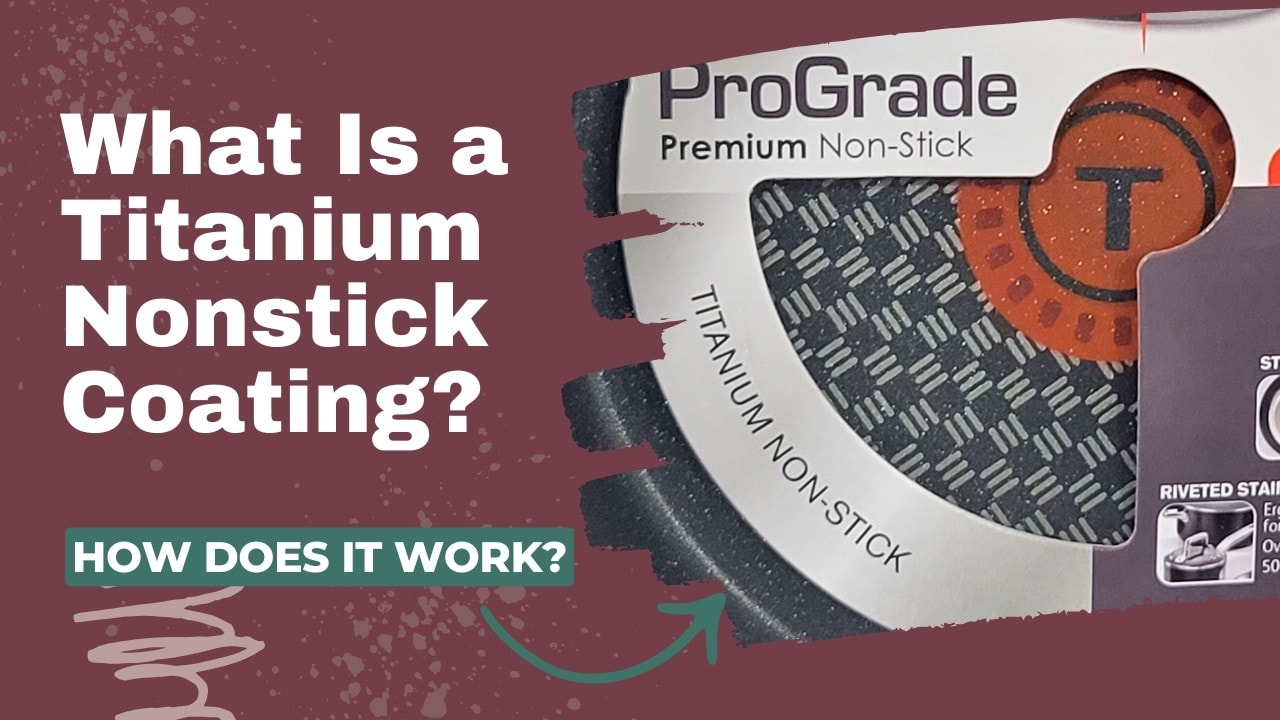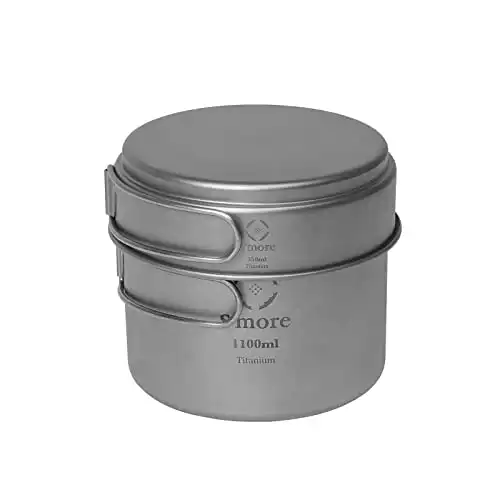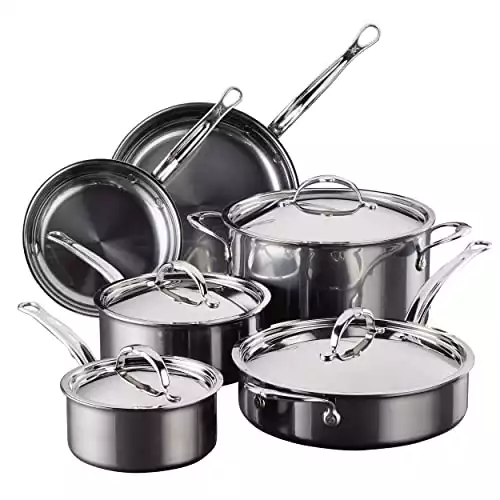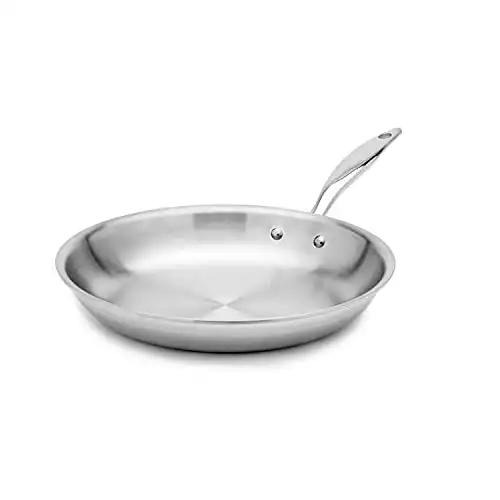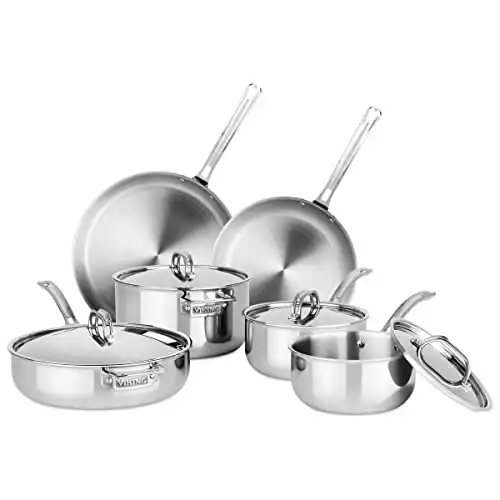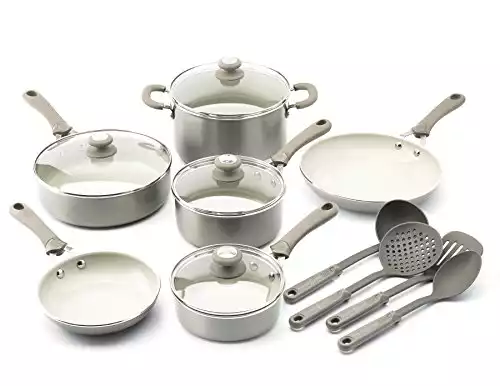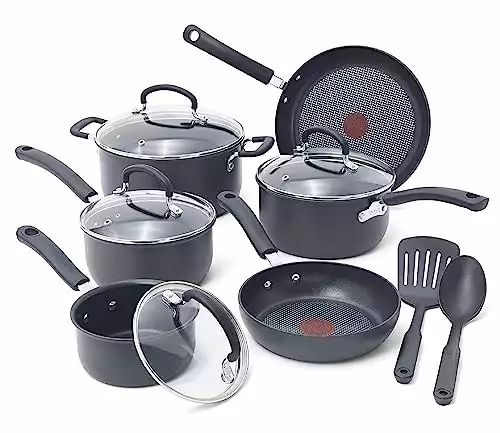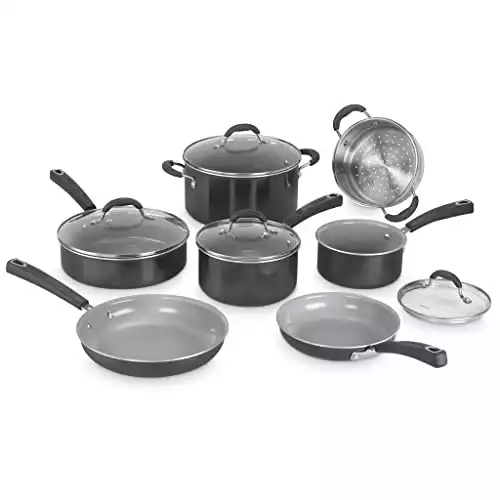Titanium is widely used in cookware. But it’s often there for its marketability more than for its performance. Titanium sounds rare, valuable, lightweight, and indestructible. And it is all of those things – more or less – in its pure form.
But what is a titanium nonstick coating on a fry pan? How much titanium is found in such a coating? Will it really extend the life of your pan?
What is Titanium Nonstick Coating?
Titanium nonstick cookware is typically aluminum with a PTFE or ceramic nonstick coating infused with titanium particles. The titanium particles microscopically extend above the PTFE or ceramic coating, to protect the coating from scratches. Manufacturers say this adds durability to their nonstick pans – but this point is debatable.
How Does it Work?
There are only two types of cookware. No matter the brand name used, nonstick coatings are either made with a ceramic or PTFE (polytetrafluoroethylene, also known as Teflon) or a ceramic coating derived from silicon. Extras, like titanium, granite, or diamond dust are often added to the nonstick cookware to improve durability.
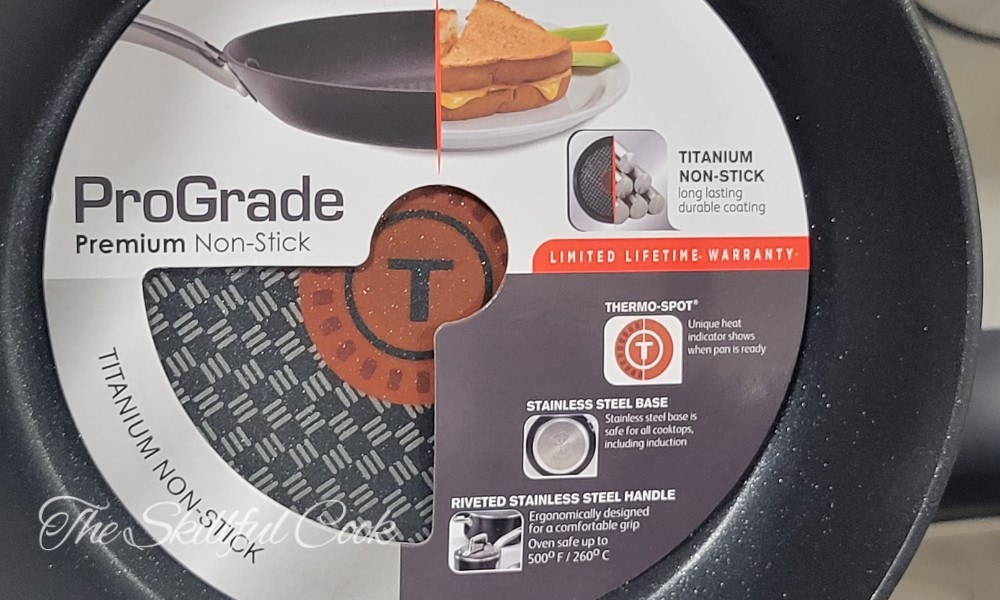
Titanium itself is a very expensive metal. It’s not nonstick, and it is a poor heat conductor. So most titanium coatings are not made of pure titanium. We don’t know how much titanium manufacturers add to their nonstick coatings to strengthen them, but it’s probably not a lot. Large titanium particles would interfere with the nonstick performance of the pan and increase the price.
Ultimately, the longevity of a titanium nonstick-coated pan depends more on the quality of the ceramic or Teflon base coating than the titanium particles themselves.
User reviews of some pans with titanium-infused nonstick coatings are excellent; others are terrible. For example, Saflon Titanium forged aluminum pans have great reviews. But some Gotham Steel titanium ceramic products were discontinued because they were so poor.
How Durable is Titanium Cookware?
As mentioned above, titanium performs a lot like stainless steel – it’s a poor heat conductor and food sticks to it. So for a nonstick pan to use titanium and still be nonstick, there has to be a very small amount of titanium mixed in the coating, much in the same way Blue Diamond cookware uses a small amount of diamond dust in its pan coatings.
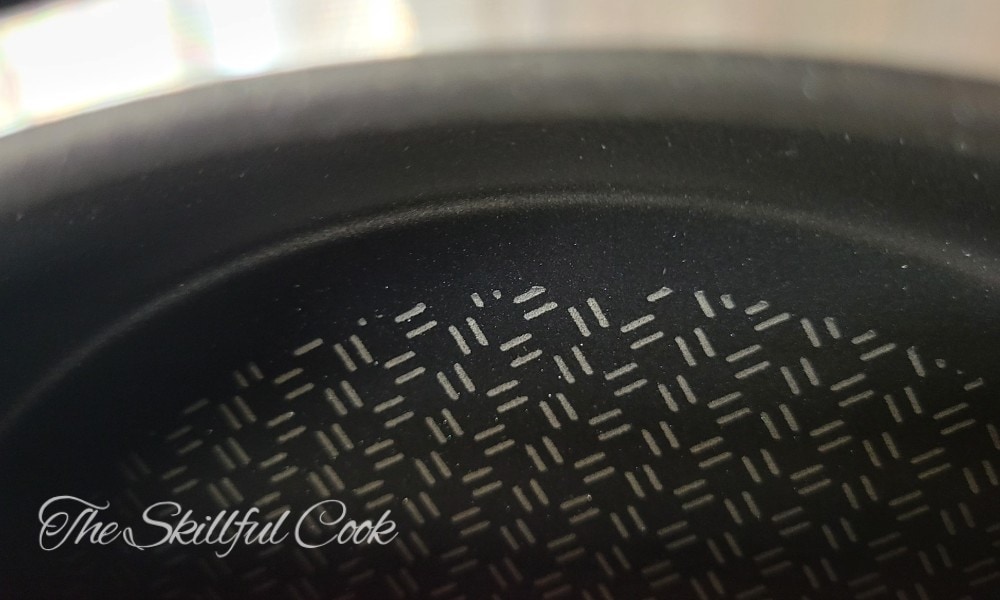
Titanium particles extend slightly above the nonstick coating to help keep utensils from scraping the coating. But the titanium particles don’t prevent the coating from heat damage or from deteriorating in other ways.
While some cookware brands offer limited lifetime warranties (like T-fal), the warranties don’t cover things like normal wear and tear, or deterioration of the nonstick coating.
The truth is that every nonstick coating has a limited lifespan. How much durability titanium adds to your cookware is up for debate, but it certainly won’t put nonstick cookware in the same durability category as cast iron cookware. At best, you’re likely to get an additional year or two of gentle use out of your titanium nonstick pan.
Titanium Nonstick vs. Titanium PTFE vs. Ceramic Nonstick
| Gotham Steel Titanium Ceramic Nonstick | T-fal ProGrade Titanium Nonstick (Teflon) | Tramontina Teflon Nonstick | Ninja Extended Life Ceramic Nonstick | |
|---|---|---|---|---|
| Price | 💲 | 💲 | 💲 | 💲💲 |
| Size | 10.25” Frypan | 10” Frypan | 10” Frypan | 10.25” Frypan |
| Amazon Rating | 3.7 | 4.6 | 4.6 | 4.6 |
| Contains Titanium | Yes | Yes | No | No |
| Induction Compatible | No | Yes | No | Yes |
| Oven Safe | 500°F (260°C) | 500°F (260°C) | 400°F (204°C) | 550°F (288°C) |
| Warranty | No** | No* | No** | 5 years* |
| Weight | 1 lb | 1 lb | 2.64 lbs | 2.4 lbs |
** This warranty is so vague it is hard to know what is covered, but the nonstick properties are never mentioned.
Other Types of Titanium Cookware
Titanium is used in several different ways in different kinds of cookware. Not all titanium pans are nonstick!
If you are shopping for nonstick pots and pans, you’ll want to make sure your search has brought up actual titanium nonstick cookware, and not one of the other kinds. Let’s take a look at some of the options a quick search may bring up.
Titanium Camping Cookware
Campers love pure titanium cookware because it’s lightweight and durable. However, it’s usually made so thin that it tends to burn food. Camping cookware is not nonstick titanium cookware.
Hestan Titanium Nanobond
Hestan’s Titanium Nanobond line uses a patented technology to fuse titanium dioxide “nano-layers” onto the pans’s surface. The pan itself is stainless steel with an aluminum core. Hestan Nanobond Titanium is not nonstick.
Stainless Steel with Titanium (316Ti)
Viking Titanium Clad Cookware
Just a Color Option
Is Titanium Cookware Safe?
Titanium itself is a safe metal. Unlike nickel, titanium is hypoallergenic. It’s biocompatible, and pure titanium and its alloys are used as biomaterials. Titanium is also non-reactive with food, so nothing harmful will leach into your food from the titanium itself. It is safe to use in cookware. I would have no concerns using, for example, the titanium-clad cookware from Viking.
Titanium nonstick coatings, though, are only as safe as the nonstick base layer. We have other articles on The Skillful Cook that discuss concerns with Teflon nonstick coatings, so I won’t go into detail here.
The point is this: if you have concerns about Teflon nonstick coatings, those concerns will still apply to titanium-infused nonstick coatings. Titanium in a PTFE coating is neither safer nor more dangerous than PTFE without titanium.
Titanium Dioxide Nanoparticles and Ceramic Cookware
The titanium found in ceramic is an interesting case. Ceramic coatings are so new that we don’t know a ton about them, but they are considered “most likely safe” by the experts at Healthline.
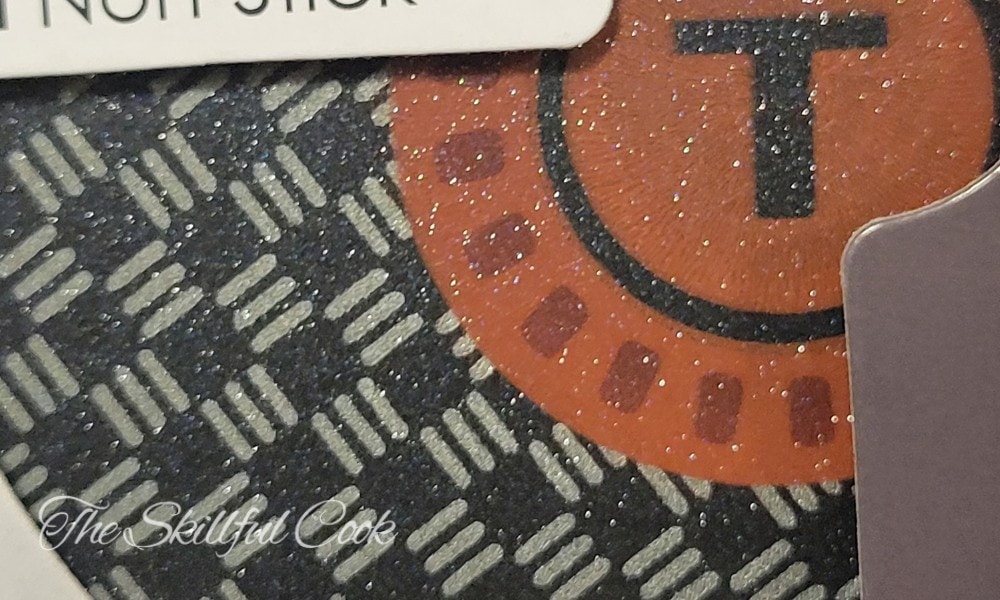
The biggest talking point against ceramic-coated cookware is regarding titanium dioxide nanoparticles, which are used to make the ceramic bond to the surface of the cookware. Nanoparticles have been shown to enter lung and cell tissue. After two years of heavy exposure to titanium dioxide nanoparticles, rats were shown to develop lung tumors.
This sounds scary, but titanium dioxide nanoparticles seem most likely to be a problem in a scratched pan. Even then, the effects of titanium dioxide nanoparticles on human health are largely unknown. Some scientists recommend “using them with great care.”
Is Titanium Nonstick Cookware Environmentally Friendly?
Titanium does not have a huge effect on the eco-friendliness of cookware. It’s non-reactive, does not rust, and is recyclable. So, again, the real answer to this question is whether or not the base coat of PTFE or ceramic nonstick and pan below it is eco-friendly.
Since nonstick-coated pans need to be replaced every few years, even if they are sprinkled with titanium, they create a lot more waste than cookware materials that last for generations, like cast iron or stainless steel. You can recycle PTFE pans, but only after the coating has been removed.
Contact your local scrapyard to see if they will take your old nonstick cookware. Some companies, such as Made In will accept any brand of cookware for recycling.
Best Titanium Nonstick Cookware
So what is the best Titanium nonstick cookware? That depends on which nonstick cookware material you prefer. As we know, there are only two types of nonstick, PTFE and ceramic cookware. Both types of cookware have their benefits and their drawbacks.
Best Titanium PTFE
Has over 11,000 reviews on Amazon with a 4.6-star rating. It has a titanium nonstick PTFE coating. This cookware is very affordable. It heats evenly and quickly, with stay-cool silicone handles for extra comfort.
The pans feel weighty like they are made of quality materials. It is oven safe up to 400°F (204°C) degrees, with the lids safe up to 350°F (176°C).
This set is not good for induction cooktops. It features a limited lifetime warranty, which excludes things like normal wear and tear, or nonstick deterioration.
Best Titanium Ceramic
A ceramic with a titanium-reinforced interior. A little more expensive than our T-Fal set, it also has excellent reviews, with a 4.5-star rating out of nearly 3,500 reviews.
This cookware has silicone handles. Customers like the weight of the pans. The cookware pieces are oven-safe to 350°F (176°C), and freezer-safe. It includes a lifetime warranty that does not cover scratches or “other damage to external or internal surfaces which does not impair the functional utility of the cookware”.
Conclusion
Titanium nonstick cookware is useful and safe for cooking, but not significantly more long-lasting than your regular nonstick pots and pans. Despite its fancy name and flashy marketing, at the end of the day, it is still either a PTFE (Teflon) pan, or a titanium-infused ceramic coating.
This isn’t to say the cookware isn’t useful or convenient. It is certainly both those things, for at least a few years. Just don’t get lulled into thinking your nonstick titanium cookware really will last forever.
Have you used titanium nonstick cookware? What did you think? Do you have any questions about titanium cookware? Share your thoughts or questions in the comments!

